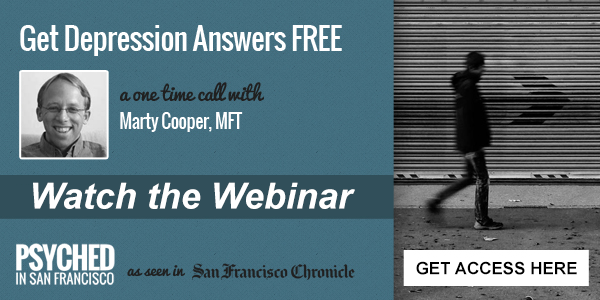Understanding Depression: Void vs. Emptiness
 Depression is a pretty odd thing, different from other “illnesses,” in that it ranges between very grungy and visceral experiences like fatigue, through problems with sleep and eating, and then into the lofty realms of the meaning of life. Well, I suppose to its credit, at least it’s not boring.
Depression is a pretty odd thing, different from other “illnesses,” in that it ranges between very grungy and visceral experiences like fatigue, through problems with sleep and eating, and then into the lofty realms of the meaning of life. Well, I suppose to its credit, at least it’s not boring.
Understanding depression calls us to learn to use the full range of ourselves in service of healing. If it were a musical instrument, it would be much more like learning the drumset versus the recorder: all the limbs eventually have to be included and coordinated, otherwise we are playing a pretty messy rhythm.
To heal from depression, in addition to learning how to build very concrete structures of support (“When sad, call Joe. At Noon, eat soup”), programming in support for body (“Wednesday, let Joe take me out for run”), challenging our negative thoughts as thoughts (say, with something as simple as a paper-and-pencil mood tracker), we are also forced to attend to the loftier and profounder realms of our own experience. Unlike a sprained ankle, depression is very much a philosophical disorder. It functions to suck the life out of experience, to drain us of desire, and therefore, like it or not, it forces us to look at our own system and experience of meaning. But unlike some undergrad class, with depression, “philosophy” becomes extremely visceral, becomes deeply felt, and is most often extremely painful.
So this article is about that deeply felt terrain of meaning, and the two realms what I’m calling Emptiness and Void, that we simply have to pay attention to, in the same way (back to the drumset) that we can’t only focus on the snare and ignore the bass drum and expect to get a satisfying beat going.
Void and Emptiness
So, here we go, the visceral realm of meaning: there’s a critical distinction between the experiences of Void and that of Emptiness that it behooves us who experience anxiety and depression to know about. (I’ll give a broad description of this terrain and then a specific example at the end.)
“Void” here refers to “the presence of absence.” It is experienced as a closed, retracted, painful state, like touching into a pocket of acid. It is the equivalent of a abscess in the body. It’s not empty space. It’s full of toxins and dead material, but is trapped in a bubble. When we experience Void, we are experiencing a place in our psyche where what was, or should be, in that space has collapsed or been destroyed. It is without positive energy, uncreative, pulling in the way an acid eats at its surroundings.
“Emptiness,” in contrast, is the “presence of potential.” This state is experienced as open, creative, full of potential in the form of abundant energy. It is without forms, but is not a space of destroyed or pulverized forms (as with the Void). It invites us into it, is not (when we are fully recognizing and encountering it) threatening, is not toxic or unsafe. The archetypal open meadow on a sunny day in Spring, lying on our backs staring up, is the state of “Emptiness”: we are not threatened by the space, and can feel and tap into the vast energy and possibilities. It is a space in which the lack of “objects” is not experienced as horrid; we are drawn to this space, when we recognize it, because it is where life arises.
The Void is when our systems register absence as threatening, unsafe; Emptiness is when our systems register absence as safe, open space. Void is the product of something destroyed which has not been grieved and healed; the wreckage of that destruction is trapped in and as the Void.
The problem is when these two get confused, and in our attempts to stay out of the wreckage and toxicity of the Void, we mistake Emptiness for Void and then, understandably, avoid it. Which creates a painful dilemma: to clarify the difference between Void and Emptiness requires us to study their difference, but this study feels akin to trying to distinguish between a rattlesnake and a garden snake. To get close triggers the sense of danger, and we retract…and yet this study is what we have to do to reclaim Emptiness. If we don’t, then our own attempts to be safe by not being consumed with Void, also starves us of the energy and abundance in Emptiness.
This fundamental misperception is pervasive in depression, and creates a core dilemma: the life energy we need, and seek, is in the open space of absence, but our experiences identify absence as only Void. Such that, when we experience Emptiness, it quickly gets mis-felt as only Void. Then life seems to be continuously consumed by Void. (The film The Never Ending Story presents this magnificently in depicting Void as “The Nothing,” which progressively consumes all life, until the protagonist finds Emptiness, in the form of imagination, and is able to take that raw potential and, from “nothingness,” restore life.)
We try to solve this terrible dilemma by throwing stuff into the Void, hoping to fill it up. Drugs, relationships, work, things, philosophy, all can be used to cover over the experience of Void, or to act like pitons anchoring us on the edge of a cliff. We get a sense of control, of order, of meaning. But they don’t last forever. Void keeps pulling for attention, but we confuse that with pulling us for our life energy and contract, desperately, clinging to whatever has some solidity to avoid what feels like a decomposing of our selves, like falling into a black hole.
Eventually, we have to give our attention to the Void. But we have to anchor ourselves well to do so. Or perhaps it’s more like building channels for storm water, that keeps them from flooding and drowning everything around. We do this through relationship, through building faith (which at essence is the projection of openness into uncertainty), through building trust in even the existence of Emptiness, and then in its reality through accumulations of experience of the Emptiness as separate from the Void. It requires measured grief, because the Void is (at least in an aspect) unfinished grief over past losses and destructions. We need company and skillful guides and maps, to point out how Void differs from Emptiness, and to hold us steady when we’re tottering over the cliff, looking down.
The Story of Sarah
At 28, Sarah’s life was going along just fine. Work was enjoyable, and it looked like she’d keep on track with promotions. She was looking for a longer-term relationship, but she was also enjoying dating, not feeling a need to rush. She’d had one bought of depression in late high school, around moving schools, but it had passed fairly quickly. Then her mother, who Sarah was very close to, had suddenly died from an aneurism. Sarah had thought she was dealing with it with normal grief, and was getting from, and giving support to, her family. Then, six months after her mother’s death, when Sarah felt that she was getting back to a relative normal, she suddenly dropped into a disabling depression. She was able to function at work, but just barely.
The main change was in her sense of meaning. Life had felt rich and abundant, even after her mother passed, but something about the quieting of her grief caused an unexpected, and apparently unprecedented, sense of meaninglessness to surround her. She wasn’t inviting it; she’d never had a particularly dark or nihilistic philosophy of life. But where her unexamined cheer and positivity had been, there opened a gaping void. She woke in the morning and instead of holding her day in her imagination as full of interest and progression and potential, she “saw” only a dark nothing, a “presence of absence,” a “lacuna of meaning”: what had been there was gone. Obviously her mother was gone, but this Void was of something much more fundamental.
This Void is a hallmark of depression, and Sarah had the wisdom to seek out help in finding a therapist. Their work focused primarily in rolling back this Void, and making more space to find the experience of what I’m calling here “Emptiness,” which had been implicit in Sarah’s life prior to her mother, but had to be made explicit now in order to find her way out of the Void. She hadn’t realized there was a Void before, but in being dunked in it, she had to learn about what it occludes (in depression): the state and experience of openness, trust, possibility, and abundance.
Through painful months of swimming in that Void (while roped to her therapist), she began finding meaning in a deeper aspect of herself and her life than she had known. Her relationship with her mother had been deep and nourishing, but also (she discovered) had occupied the central position of meaning in her life. When her mother died, Sarah lost both mother and meaning. But what happened was that she began having experiences—first as flashes, and then more stably—where she began experiencing “Emptiness” without being confused with Void. Both states are similar because they both are “spaces,” but are radically different in that one is “full of fullness,” and the other is “full of lack.” She began to see how those qualities of Emptiness were not lost when she lost her mother, that they had never been fused to her actual mother, and that she could find them more and more in just the process of Being. It was there that the depression was essentially broken and she returned to her stream of life, bruised but wiser.

